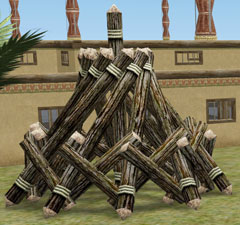The Wiki for Tale 6 is in read-only mode and is available for archival and reference purposes only. Please visit the current Tale 11 Wiki in the meantime.
If you have any issues with this Wiki, please post in #wiki-editing on Discord or contact Brad in-game.
Bonfire

| |
|---|---|
| Size | N/A |
| Where | Outside |
Overview
A Bonfire is a pile of wood in the form of a building. Wood can be removed from, and added to, the bonfire at any time; the pile will remain as long as some wood is left. The size of the bonfire varies depending on how much wood is in the pile.
Bonfires may be lit, consuming all of the wood and leaving behind a quantity of charcoal. This is a highly inefficient, if entertaining, method of charcoal production. Lit bonfires figure prominently in the Festival of Ra.
Source
This building becomes available with Controlled Burn technology.
Cost
- Any amount of Wood
Built Outside.
Use
Bonfires are commonly used for wood storage. As their size is dependent on how much wood is in them, it's advisable to put them in an area where they can grow. If you accidentally light one on fire, tearing it down immediately will recover all the wood.
T3: To bake bread, start with a bonfire of 105 wood. Let burn to 0, then add the bread. Stoke with 1 wood and 1 water, repeated 30-400 times.
Charcoal
As of T5, we can once again use bonfires to create Charcoal. However, the payoff seems to be extremely limited. It appears yield is based on a very simple formula of #wood/10 = #cc, with any remainder dropped. So, 10 wood will produce 1 cc, as will 11, 12, ... 19. 20-29 will produce 2 cc. And so on.
Here are some observed yields:
| # wood | cc yield |
| 7 | 0 |
| 10 | 1 |
| 14 | 1 |
| 20 | 2 |
| 30 | 3 |
| 35 | 3 |
| 42 | 4 |
| 49 | 4 |
| 56 | 5 |
| 63 | 6 |
| 100 | 10 |
| 250 | 25 |
Initial experiments with stoking indicate that it does NOT increase charcoal yield. In fact, it seems that the starting amount of wood determines the output regardless of amount of stoking. So if you start a 20 wood fire and stoke with 2 wood fifty times, you still get 2 cc and are throwing 100 wood away.